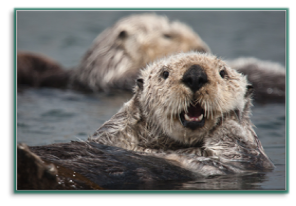Sea Otters: A Dwindling Species that Helps to Diminish Our Carbon Footprint
By Alex Babcock,
Marine conservation student
Sea otters are recognized most for their cute appearance and adorable behaviors; however, this species also serves very important roles in its’ ecosystem. A new study, published in this month’s issue of Frontiers in Ecology and Environment, posits the importance of sea otters and carbon sequestration (Wilmers et al. 2012). We know the ocean is one of our biggest carbon sinks and that sea otters are a keystone species for kelp forest environments (Estes et al. 1978). This study goes one step further: it demonstrates that sea otters, by keeping kelp-grazing sea urchin populations low, can cause kelp ecosystems to have higher net primary productivity (NPP) and higher biomass than kelp ecosystems without sea otters present. In effect, the presence of sea otters causes more CO2 to be absorbed from the atmosphere (Wilmers et al. 2012).
One of the many staples of a sea otter’s diet is the sea urchin. When otters are present, sea urchins tend to hide in rock crevices and feed on kelp detritus. However when sea otters are absent, urchins move more boldly out of their crevices and begin to feed on living kelp- more specifically on kelp holdfasts (i.e. kelp structures that attach the kelp individual to the sea floor) (Wilmers et al. 2012). In extreme but not uncommon circumstances, the urchin population can grow to such an extent that they destroy the entire kelp forest (Dayton et al. 1998).
To track these effects of otters, the Wilmer’s study has used and combined data collected over the past 40 years on, “differences in kelp abundance between systems with and without sea otters, the chemical composition of kelp, the net primary productivity (NPP) of kelp forests, and the areal extent of habitat suitable for kelp forest across 5400 km of the sea otter’s range in the North Pacific Ocean” (Wilmers et al. 2012). From this data, the study calculated the role of sea otters influence on the carbon cycle using two strategies. First, they would measure the carbon density in living kelp from areas with and without sea otters. Second, for the carbon flux or net primary production component, they would estimate the amount of carbon exchanged through kelp forests with and without sea otters. When the differences between areas with and without sea otters were applied to the entire study area, which was from the Aleutian Islands to Vancouver Island, the study found a 4.4- to 8.7-teragram (Tg) increase in carbon storage due to the predator effect of sea otters. The net primary productivity with sea otters was 313-900 g C m-2 yr-1 compared with 25-70 g C m-2 yr-1 in ecosystems without sea otters. Thus, the increased flux of carbon through kelp ecosystems due to the addition of sea otters (preying on sea urchins) is around 243-875 g C m-2 yr-1 (Wilmers et al. 2012).
Thanks to sea otters, this one time increase in kelp carbon of 4.4- to 8.7-Tg “accounts from 5.6-11% of the total C in a volume of atmosphere.” Or, put another way, the absence of sea otters accounts for “21-42% of the increase in atmospheric C in that same volume of atmosphere since the beginning of the Industrial Revolution” (Wilmers et al. 2012). Proportionally, this may not have a huge impact on the current total atmospheric carbon, but it is a big effect for the potential habitat range of sea otters. This study went on to estimate the economic benefit of this increased carbon if sold on the European Carbon Exchange, and claims that “the value of increased kelp C standing stock due to sea otters is US$205-408 million. If this one-time payment were invested with an 8% yield (the approximate long-term average return of the Dow Jones Industrial Average), it would provide US$16-33 million annually. Deep sea storage of kelp would fetch US$6-21 million annually if 1% of increased NPP were to sink and US$294-1060 million annually if 50% were to sink” (Wilmers et al. 2012). Notably, this estimate could be expanded, considering that this study was limited from the Aleutian Islands to Vancouver Island, and thus excluded the potential economic benefits from kelp forests along Washington, Oregon, and California coastlines.
Ultimately what this study underscores is the importance of not just sea otters, but also the effect of all large predators on the carbon cycle as a global issue. Unfortunately, protecting large predators is often viewed as too economically costly. Crucially though, we are discovering a silver lining: that in protecting large predators and the habitats in which they reside, there may be hope to recoup the cost of protecting them, and actually even profit from the services they provide. These profits could come from carbon exchange schemes, ecotourism, or from more general effects such as increased fishing capacity due to elevated biomass. Clearly, in light of the Wilmer’s study, and other on-going research in the area, our management and protection of these systems must change. We must work to better represent the great value these species hold for us all, both economically and environmentally.
REFERENCES
Wilmers C, Estes J, Edwards M, Laidre K, Konar B (2012) Do trophic cascades affect the storage and flux of atmospheric carbon? An analysis of sea otters and kelp forests. Front Ecol Environ 10(8): 409-415.
Estes J, Smith N, Palmisano JF (1978) Sea Otter Predation and Community Organization in the Western Aleutian Islands, Alaska. Ecology 59(4): 822-833.
Dayton P, Tegner M, Edwards P, Riser, K (1998) Sliding Baselines, Ghosts, and Reduced Expectations in Kelp Forest Communities. Ecological Applications 8(2): 309-322.





Trackbacks & Pingbacks
[…] Sea Otters: A Dwindling Species that Helps to Diminish Our Carbon Footprint […]
Leave a Reply
Want to join the discussion?Feel free to contribute!